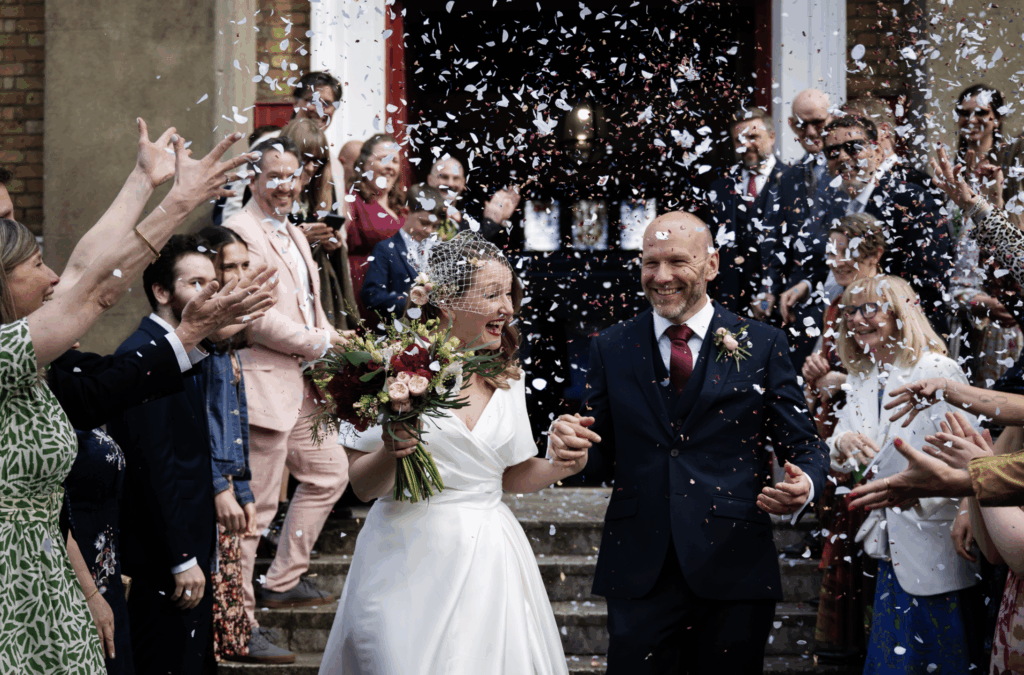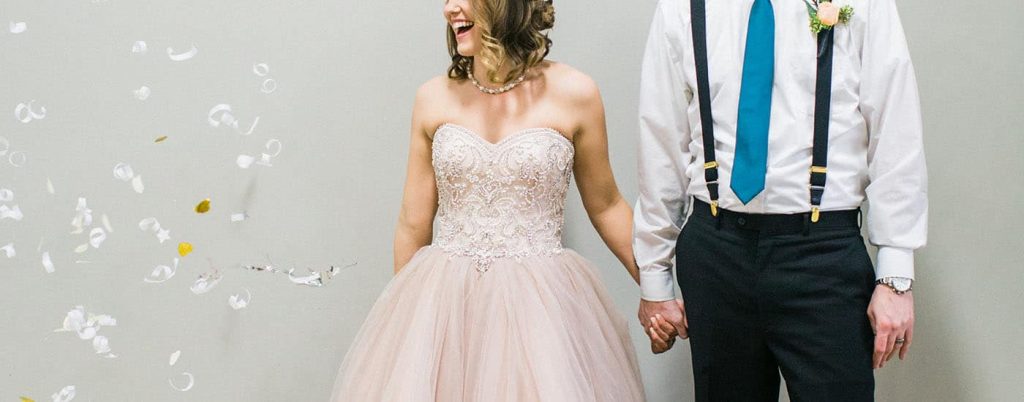How to Photograph a Petal Toss: A Wedding Photographer’s Guide

Among all the fleeting moments that make up a wedding day, the petal toss stands out as one of the most visually captivating. The sudden flurry of petals and the cheers from loved ones make this particular moment feel almost magical.
As fun and photoworthy as it is, the petal toss is also a technical challenge for photographers. It’s fast, occasionally unpredictable, and easy to miss if you’re not prepared. Capturing this moment beautifully requires more than a quick shutter finger.
You’ll need to go into a petal toss with a clear strategy. Whether you’re photographing a recessional toss at a sunny vineyard or a grand confetti-style entrance in a ballroom, here’s how to nail the petal toss every time.
Plan Ahead for the Petal Toss Moment
Photo by The Greens Photo at 5Eleven, Pensacola, FL, USA
The most successful petal toss images start well before the first handful of petals is flung. As a photographer, you need to know not only when it’s happening, but also how it’s being coordinated. Talk to the couple or planner in advance to confirm the timing, materials, and setup. This is not a detail you want to figure out on the fly.
Scheduling the Petal Toss
Photo by Taber Hespe at Geneva National, Lake Geneva, Wisconsin, USA
So, when should the petal toss happen? Petal tosses most commonly occur at the end of the ceremony, as the couple walks back down the aisle. But some couples opt for a toss during their grand reception entrance or even after portraits. If lighting or logistics weren’t ideal during the first round, don’t be afraid to suggest a re-do later in the day.
Regardless of when it happens, it’s worth blocking a few extra minutes into the timeline to prepare and set expectations with all parties involved.
Choose the Right Materials for Maximum Impact
Photo by Andreas Pollok at Fünf Finger Turm, Darmstadt, Germany
Traditionally, rice was the go-to for wedding tosses, but times (and venues) have changed. Today, popular alternatives include real flower petals, dried flowers, biodegradable paper confetti, and even lightweight silk petals. It’s important to note that these options will impact the final shot in different ways. Each brings its own aesthetic.
If you have an opportunity to help the bride and groom-to-be decide which materials to use for the toss, here are some factors to consider.
Photo by Andy Sidders Photography at Shadwell, London, UK
Fresh flower petals look gorgeous up close and bring a romantic, organic feel to the frame, but they’re heavy and fall quickly. Lightweight alternatives like dried petals, paper confetti, or biodegradable options tend to float longer, creating that dreamy, suspended-in-air effect. And rice, the old-time favorite, can create a showering effect unlike any other when tossed in abundance.
Photo by Stefano Ferrier at Milano Church, Milano, Italy
Environmental Considerations & Venue Restrictions
For more environmentally conscious couples, or venues with restrictions, options like bubbles, mini flags, or even ringing bells can be lovely alternatives. They still create movement and energy without leaving behind a mess. Just be sure to confirm ahead of time that the venue allows for tosses, and what types of materials are permitted. Many only allow biodegradable petals, especially outdoors.
How Much Should You Toss?
Photo by Andy Sidders Photography at Lillibrooke Manor, Maidenhead, UK
To get that magical, fully immersive look in camera, quantity matters. One or two petals per guest won’t cut it. Ideally, aim for about 1–2 cups per person. A sparse sprinkle won’t give you that full, immersive look that we often associate with petal toss photos.
Encourage couples to provide guests with small cones, organza bags, or paper cups filled with petals or confetti. These containers not only help with distribution, but also add a touch of style to the wedding décor.
How Should the Petals Be Tossed?
Photo by Picturist Photography at Pebble Beach Resort Golf Course, Carmel, California, USA
A successful petal toss is part choreography, part timing, and part spontaneity. The key is in how the guests toss, not at the couple, but upward and in front of them. You want the petals to rain down gently in front of the couple rather than smacking them in the face mid-laugh.
Photo by Gretchen Troop at Della Terra Mountain Chauteau, Estes Park, Colorado, USA
Encourage guests to lift their arms high and throw with enthusiasm. Big smiles, arms in the air, and celebratory energy go a long way in making the image feel alive. If possible, enlist someone (a planner, second shooter, or even a friend) to throw a few extra handfuls from behind or beside the photographer. This creates foreground elements and adds an immersive feel to the image, like you’re inside the moment, not just observing it.
Full Bouquets
Photo by Jeff Tisman at Rock Island Lake Club, Sparta, NJ, USA
You can also turn the petal toss into a full bouquet toss! Look for a creative angle, like the bottom-up perspective illustrated above, and capture a one-of-a-kind toss!
Dial In Your Camera Settings
Photo by Stefano Ferrier at Pavia church, Pavia, Italy
Because the petal toss happens quickly, often in bright light, and with a lot of movement, your camera settings need to be locked in ahead of time. This isn’t the moment to experiment. More often than not, your goal will be to freeze the petals mid-air while keeping the couple sharp and expressive.
Recommended camera settings:
- Shutter Speed: 1/1000 or faster to freeze motion
- Aperture: f/2.8 to f/4 for a slightly shallow depth of field that keeps focus on the couple but gives dimension to the scene
- ISO: Adjust based on ambient light; ISO 400–800 is typical outdoors, higher indoors if using flash
- Drive Mode: High-speed continuous for rapid bursts
- Autofocus: AF-C or AI-Servo with a single focus point on the couple’s faces
Build a Beautiful Business.
Pre-focus your shot where the couple will be walking, and don’t be afraid to overshoot. With petals flying, expressions changing, and guests cheering, you’ll want as many frames to choose from as possible.
Positioning: Where to Stand for the Best Shots
Photo by Michael Freas at Playa Largo Resort, Key Largo, Florida, USA
Your physical position can make or break a petal toss image. In most cases, standing directly in front of the aisle, a few feet beyond the guest line, gives you a straight-on view of the couple walking into the celebration. This angle lets you capture their faces, movement, and the cascade of petals in one dynamic frame.
Photo by Jeff Tisman at The Ashford Estate, Allentown, NJ, USA
If you’re working with a second shooter, have them stand behind the couple for a reverse view—this captures the full scale of the celebration, the toss from guests, and any stunning backdrop behind the ceremony space. You can also experiment with:
- Lower angles: Shooting slightly upward gives petals more sky or ceiling space to float into.
- Wide shots: Use a 24–35mm lens to capture the full guest reaction and petal volume.
- Close-up shots: Switch to 50–85mm for tighter crops of facial expressions and petal detail.
Photo by We, The Light Photography at Airbnb in Frisco, CO, USA
For extra magic, ask an assistant to toss a few petals in front of your lens from your side. It creates a gorgeous blurred foreground and gives the illusion that the viewer is in the middle of the moment.
Lighting the Scene for Drama or Softness
Photo by Green Apple Weddings at The Canopy by Hilton, Palm Beach, Florida, USA
Natural light is your best friend during a petal toss. Open shade or backlighting conditions are ideal as they minimize harsh shadows on faces and allow petals to glow. Because this is more of an action shot and the couple doesn’t usually look into the camera the way they would for a posed shot, however, don’t let harsh sunlight scare you. If you’re outdoors in full sun, position yourself so that the sun is behind the couple or slightly to the side, not directly overhead or front-facing.
Photo by Andreas Pollok at Grenzhof, Heidelberg, Germany
If the toss takes place indoors or in low light (common during reception entrances), prepare for off-camera flash or on-camera bounce. A flash with a diffuser aimed toward the ceiling or a nearby white surface can help light the scene softly without flattening it.
Don’t Be Afraid to Do It Twice
Photo by Kevin Heslin at Costa Verde Hotel, Manuel Antonio, Costa Rica
Here’s a seasoned pro move: if time and budget allow, stage the petal toss twice. The first run often catches people off guard. Some guests forget to toss, others toss too soon or too late, and the couple might be nervous or overwhelmed. The second time around, everyone’s more relaxed, and you get another shot at refining your composition, angle, or exposure.
Making the Most of the Petal Toss
The petal toss is a unique combination of movement, emotion, and visual storytelling all packed into a matter of seconds. When photographed with intention and artistry, however, it can result in one of the most striking frames in a couple’s wedding gallery. So, prep your settings. Communicate with the planner. Scout your angles. Do these things, and when the moment comes, you’ll be ready. The petals may fall quickly, but the impact of that shot? It can last a lifetime.
Check out these additional petal toss photos for more inspiration:
Photo by We, The Light Photography at Airbnb in Frisco, CO, USA
Photo by Kevin Heslin at Playa Espadilla, Manuel Antonio, Costa Rica
Photo by Luzye Photography at Occasions at Laguna Village, Laguna Beach, California, USA
Photo by SMJ Photography at Eden Resort, Lancaster, PA, USA
Photo by SMJ Photography at Mount Hope Estate & Winery, Manheim, PA, USA
Photo by Michael Freas at Hemingway House, Key West, Florida, USA
Photo by Kevin Heslin at Pangas Beach Club, Tamarindo, Costa Rica
Photo by The Greens Photo at St. Thomas More Church, New York City, NY, USA
Photo by Jeroen Savelkouls at Kasteel Kerckebosch, Zeist, The Netherlands
Photo by Gretchen Troop at Della Terra Mountain Chateau Estes Park, Colorado, USA
Photo by Francis Sylvest at Private Estate, Steamboat Springs, Colorado, USA
Photo by Vow of the Wild at Winter Park, Colorado, USA
 Get 50% off any plan!*
Get 50% off any plan!*

